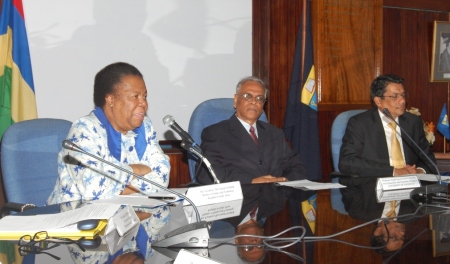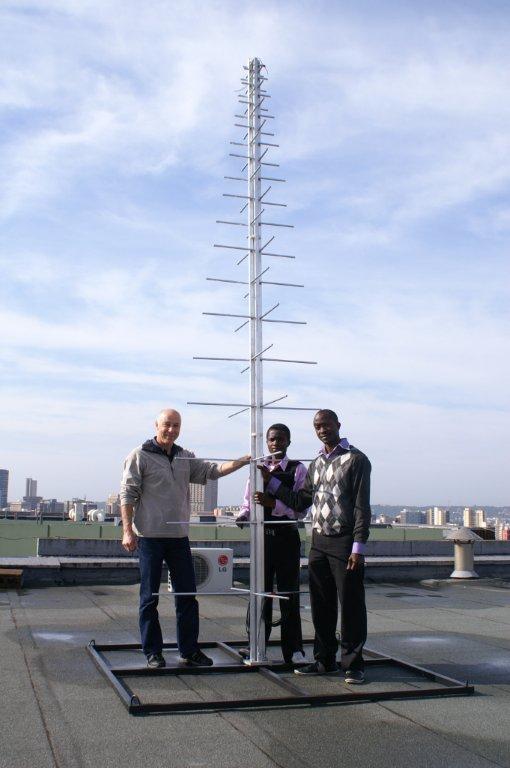Mitra Project
Multifrequency Interferometry Telescope for Radio Astronomy in Mauritius
In the context of the collaboration of South Africa and partner countries on the Square Kilometre Array Radio Telescope (SKA) project, Her Excellency Mrs. Naledi Pandor, Minister of Science and Technology of the Republic of South Africa, visited the University of Mauritius on Monday 19 September 2011.

A working session was conducted with Dr the Hon. Rajeshwar Jeetah, Minister of Tertiary Education, Science, Research and Technology, University representatives and academics of the Faculty of Science and various other key partners.
The SKA Radio Telescope is one of the most powerful and sensitive telescopes, to be built in Africa. Mauritius and South Africa have also jointly embarked in the building of a low frequency array telescope, called Multifrequency Interferometry Telescope for Radio Astronomy (MITRA) with stations in both countries. In Sanskrit mitra means friend.
The planning started a few years ago in a collaboration led by Dr Girish Kumar Beeharry, from the University of Mauritius (UOM), and Stuart David Macpherson and Gary Peter Janse Van Vuuren, from the Durban University of Technology (DUT). As it is the custom at the University, to consolidate collaboration and friendship, a Tree Planting ceremony was held in front of the University cafeteria.

Thereafter, H.E. Mrs Naledi Pandor headed for the MITRA at the Mauritius Radio Telescope (MRT) site at Bras d’Eau, Poste de Flacq. The MITRA is a radio astronomy project which aims to do extremely wide field imaging with heterogeneous non coplanar arrays.The first two MITRA nodes are being developed collaboratively at the MRT site and at the DUT campus site, Durban, South Africa. The DUT has received funding to this effect from the Department of Science and Technology, South Africa (DST SA). The design of these nodes is such that each can be expanded in intra-nodal groups of antennas to form a nodal array of antennas. Radio astronomy observations will be done at each node. The radio data from a number of nodes will be combined to form an internationalaperturesynthesis telescope using techniques of Very Large Baseline Interferometry (VLBI).

The core drivers of the partnership will evolve around human capital development, high performance computing, enhanced technology for space science and attracting research scientists to Africa. Presently, the first two antennas have been built at the MRT site. Preliminary tests have been conducted and the first solar flares have been observed with the new antenna.
Description
-A sensitive high resolution multi-frequency dual polarity instrument in the range 30 to 800 MHz using multiple stations of low-cost dipoles, such as log-periodic antennas.
- Baselines will range from a few metres, in one station, to some 250-500-1000-3000-5000 km for the whole instrument
The instrument & each station is modular in nature
- A station will be able to function in its own right
- Subsets of the whole instrument could also be used.
- The desired final technical specifications of the whole instrument are a function of the number of participants.
Station outline
- Each station is planned for observations on own.
- Sufficient sensitivity and resolution built in
- The front-end & the back-end should be integrated with the data acquisition locally.
- The data pipeline should also cater for intra-station as well as inter-station correlation.
-Local hub managing system which will be synchronised, by the central hub, with other stations.
Technology
- Near real time Very Long Baseline Interferometry (VLBI) and Electronic-VLBI
- Data Management
- High Capacity Correlation
- Digital Data Processing
- Antenna design
- Receiver system design
- Data acquisition system design
- Radio Frequency (RF) Electronics
- Networking
- Digital Subscriber Line (DSL) Communications
Science
Extremely Wide Field Imaging
- Issues of Non-coplanarity
- Analysis Algorithms for Radio Maps
- Solar: flares, coronal mass ejections
- The Galaxy and the galactic centre star forming regions
- Galaxies and clusters of galaxies,
- Pulsars
- Supernova Remnants
- Transient sources
- Spectral and recombination line observations
- Study of spectral indices of sources
- Interstellar scintillation: lower end of spectrum
- Jupiter: lower end of spectrum
- Ionospheric and Space Weather
